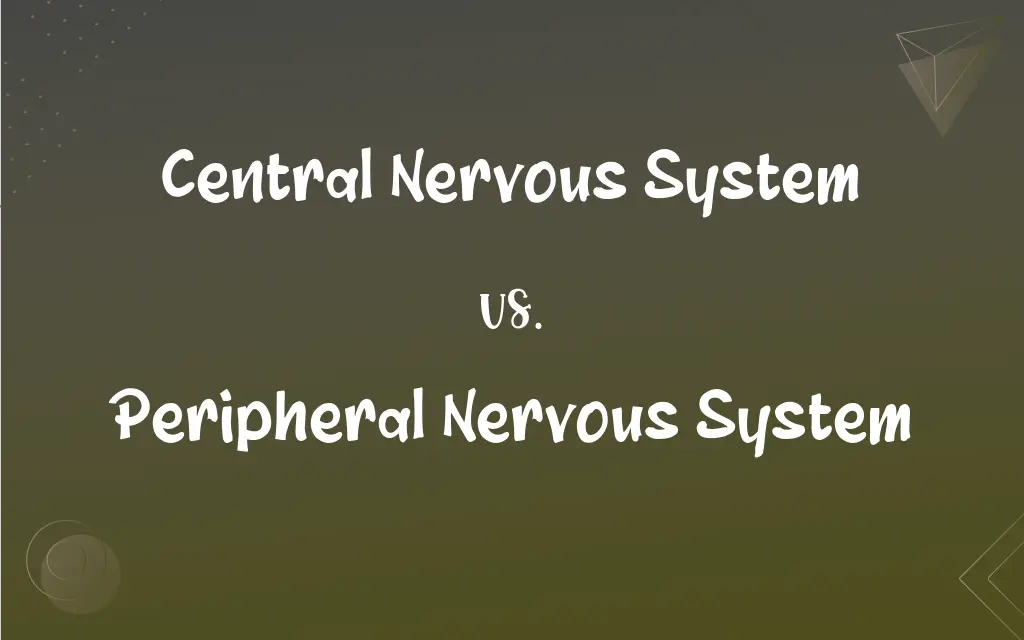Central Nervous System vs. Peripheral Nervous System: What's the Difference?
Edited by Aimie Carlson || By Harlon Moss || Published on March 23, 2024
The central nervous system (CNS) comprises the brain and spinal cord, controlling most functions of the body and mind, while the peripheral nervous system (PNS) consists of all other neural elements, linking the CNS to the body's limbs and organs.

Key Differences
The central nervous system (CNS) and the peripheral nervous system (PNS) are two primary components of the body's nervous system, each playing crucial roles in bodily function. The CNS is the control center of the body, comprising the brain and spinal cord. It processes information and dictates actions by sending signals through the PNS, which consists of nerves and ganglia outside the brain and spinal cord.
The CNS processes and integrates information it receives from the body and sends out commands, the PNS acts as a communication line between the CNS and the rest of the body. The PNS is divided into the somatic nervous system, which controls voluntary movements, and the autonomic nervous system, which controls involuntary functions like heartbeat and digestion.
The CNS's role is primarily in processing information and determining the appropriate response. The brain interprets sensory information, while the spinal cord facilitates the transmission of this information and carries out responses. The PNS, on the other hand, includes all the sensory and motor neurons that extend from the CNS to the rest of the body, facilitating the execution of these responses.
In terms of protection, the CNS is shielded by the skull and vertebral column, as well as the meninges and cerebrospinal fluid, which provide additional layers of protection against injury. The PNS, while also protected by bones in some areas, is more exposed and susceptible to damage due to its distribution throughout the body.
The CNS and PNS work together seamlessly to maintain homeostasis and enable complex behaviors. The CNS makes decisions and sends instructions via the PNS to various body parts, which then send sensory feedback to the CNS through the PNS, creating a continuous loop of communication that regulates bodily functions.
ADVERTISEMENT
Comparison Chart
Components
Brain and spinal cord
Nerves and ganglia outside the brain and spinal cord
Function
Processes information; commands body
Communicates between CNS and limbs/organs
Division
Not divided into subcategories
Divided into somatic and autonomic nervous systems
Protection
Protected by skull, vertebral column, meninges, and cerebrospinal fluid
Less protected, more exposed to injury
Role in Control
Direct control over body functions
Facilitates execution and feedback
ADVERTISEMENT
Central Nervous System and Peripheral Nervous System Definitions
Central Nervous System
The CNS processes sensory information.
The central nervous system interprets signals from the eyes to create visual perception.
Peripheral Nervous System
The PNS transmits sensory information.
The peripheral nervous system alerts the body to changes in temperature.
Central Nervous System
The CNS integrates cognitive functions.
Learning new information involves changes in the central nervous system's neural pathways.
Peripheral Nervous System
The PNS regulates involuntary activities.
The peripheral nervous system manages digestion without conscious effort.
Central Nervous System
The central nervous system (CNS) is the body's primary control center.
Injuries to the central nervous system can have significant impacts on bodily functions.
Peripheral Nervous System
The PNS controls voluntary movements.
Walking is coordinated by signals from the peripheral nervous system to the leg muscles.
Central Nervous System
The CNS coordinates movement.
The central nervous system sends signals to muscles for coordinated movement.
Peripheral Nervous System
The peripheral nervous system (PNS) connects the CNS to the body.
Damage to the peripheral nervous system can impair sensation and movement.
Central Nervous System
The CNS regulates bodily functions.
The central nervous system controls heart rate and breathing during exercise.
Peripheral Nervous System
The PNS facilitates healing and regeneration.
Nerves in the peripheral nervous system have a limited ability to regenerate after injury.
FAQs
How does the CNS process information?
It receives, interprets, and sends out responses based on sensory information.
What comprises the central nervous system?
The brain and spinal cord.
What role does the PNS play in the nervous system?
It communicates information between the CNS and the rest of the body.
How is the PNS protected?
It's less protected but some nerves are shielded by bone or muscle.
What does the peripheral nervous system include?
Nerves and ganglia outside the brain and spinal cord.
Can the CNS regenerate after injury?
Regeneration in the CNS is very limited due to its complexity and protection mechanisms.
How do CNS and PNS work together?
The CNS processes information and makes decisions; the PNS implements these decisions and provides feedback.
Can the PNS regenerate after injury?
Yes, nerves in the PNS have some capacity for regeneration.
What protects the CNS from injury?
The skull, vertebral column, meninges, and cerebrospinal fluid.
What is the autonomic nervous system?
A part of the PNS that controls involuntary functions.
What is the somatic nervous system?
A part of the PNS that controls voluntary movements.
What are some common issues in the PNS?
Peripheral neuropathy, carpal tunnel syndrome.
Why is the CNS considered more complex than the PNS?
Due to its role in processing and integrating a vast range of sensory and cognitive functions.
How does the PNS affect physical sensations?
It transmits sensory information from the body to the CNS.
What are some common diseases of the CNS?
Alzheimer's disease, Parkinson's disease, multiple sclerosis.
How do injuries differ between the CNS and PNS?
CNS injuries are often more severe and less likely to heal, while PNS injuries may recover over time.
What is neuroplasticity in the context of the CNS?
The ability of the CNS to reorganize its pathways based on new experiences.
Can the functions of the CNS and PNS overlap?
While their functions are distinct, they are interdependent for overall body regulation.
What advancements have been made in treating CNS disorders?
Developments include neuroimaging techniques, medications, and therapies aimed at enhancing neuroplasticity.
What treatments are available for PNS injuries?
Treatments include physical therapy, surgery, and medications to promote nerve regeneration and reduce symptoms.
About Author
Written by
Harlon MossHarlon is a seasoned quality moderator and accomplished content writer for Difference Wiki. An alumnus of the prestigious University of California, he earned his degree in Computer Science. Leveraging his academic background, Harlon brings a meticulous and informed perspective to his work, ensuring content accuracy and excellence.
Edited by
Aimie CarlsonAimie Carlson, holding a master's degree in English literature, is a fervent English language enthusiast. She lends her writing talents to Difference Wiki, a prominent website that specializes in comparisons, offering readers insightful analyses that both captivate and inform.
































































